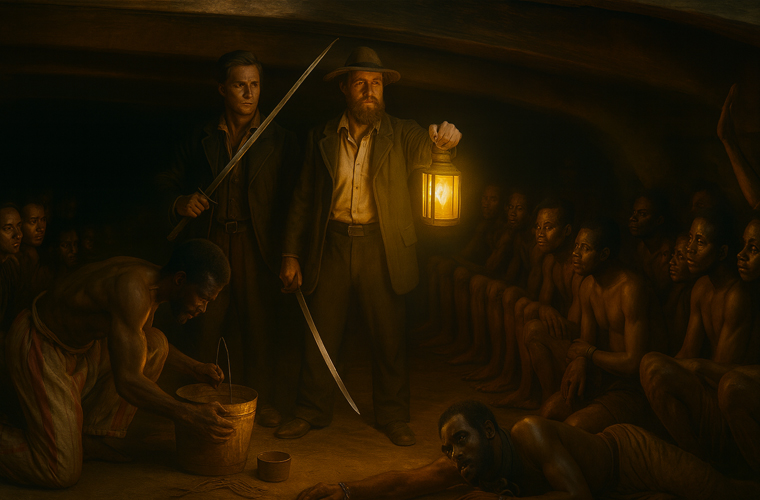The recent unearthing of the Portuguese slave ship São José’s wreckage off Cape Town has spotlighted East Africa’s overlooked involvement in the transatlantic slave trade. Yet the São José was just one among countless slave ships that either skirted the Cape or anchored in Table Bay to resupply.
The São José’s wreck, just two days after Christmas in 1794, capped a disastrous year for the slave trade around the Cape of Good Hope. Earlier that April, the French vessel Jardinière had sunk near Cape Agulhas, with roughly 185 slaves washing ashore—though many perished from exhaustion or fled, leaving only 125 to be sold at auction in Stellenbosch.
France’s republican government had banned slavery and the trade outright, while in Britain, a swelling outcry condemned the annual uprooting of 80,000 Africans to the Americas.
Slave rebellions
With Britain and France back at war after a decade of uneasy peace, slave-laden ships became easy prey for naval forces and privateers alike. Compounding the chaos, East Africa’s primary market in the Americas was engulfed in revolt: enslaved people had seized vast swaths of Saint-Domingue, the French West Indies jewel that would soon emerge as Haiti a decade later.
The rampaging destruction of sugar plantations in France’s richest colony obliterated the demand for East African slaves. The São José, then, blazed a trail toward a fresh outlet in Brazil—a tough sell, given the stranglehold Angolan and Congolese traders had on supplying Portuguese America.
East Africa entered the transatlantic slave trade late in the game. It wasn’t until the 1770s that steady shipments began flowing from coastal outposts to the French islands of Mauritius and Réunion. For over a century prior, a trickle of slaves had looped around the Cape. But as Saint-Domingue’s planters clamored for workers, the route turned lucrative and organized, boosted by royal French subsidies for deliveries to the island.
West-Central Africa shouldered most of the burden at first. But soaring prices pushed traders eastward for more “merchandise.” Even though the voyage from Mozambique to Saint-Domingue dragged on for about 120 days—with nearly 30% of captives dying en route—it soon proved a goldmine.
A classic triangular trade took shape: vessels departed French harbors like Bordeaux and Nantes to procure slaves in East Africa, ferried them across to Saint-Domingue for swaps of sugar, coffee, and indigo, then looped back. By the 1780s, these ships ballooned in size, some packing up to 1,000 souls.
Rebellions were commonplace, so crews swelled with armed guards to quash defiance. The East African trade crested in 1789–90, as some 46 ships—hauling over 16,000 slaves—sailed past the Cape, nearly all destined for Saint-Domingue’s northern sugar and coffee estates.
Cape colony and slavery
During this frenzy, many French slavers paused at the Cape, courtesy of the Dutch East India Company’s outpost, which offered a vital respite mid-voyage. Captains often offloaded the frailest slaves here, slimming their loads to stock up on provisions and water. The Cape also let them recruit replacements for lost or ailing sailors, gather intel on coastal slave markets, or relay reports of onboard crimes back to France.
Certain French ships dumped their full human loads at the Cape for sale, while others bartered sugar, coffee, and rice for local ivory and gold to freight northward. Crucially, slaves could disembark to stretch their limbs before the brutal Atlantic haul—a practice the Dutch Company loathed, viewing captives as disease vectors like smallpox carriers and fretting over escapes or black-market sales.
Colonial officials recoiled too at the influx of hundreds of gaunt, barely clothed slaves, many sick or broken. The initial Mozambique-to-Cape leg spanned roughly 35 days, claiming lives at a grim clip. Captives, often yanked from deep inland, arrived starved and battered, then crammed into suffocating holds as ships lingered offshore, haggling for more. Shackled in decks barely a meter tall, stripped bare to curb lice, these vessels resembled seafaring hells.
Unaccustomed rations and relentless toil bred dysentery and gut fevers that sapped their strength. Denied soap or oils, they fell victim to flies spreading craw—a scourge sparking brutal skin sores and, at times, river blindness.
Dutch ease Slave Monopoly
The August 1791 slave revolt in northern Saint-Domingue sounded the death knell for France’s East African trade. In a frantic bid to salvage things, the Dutch East India Company ditched its trade monopoly a year on, greenlighting private imports of slaves to the Cape.
The São José likely sprang from this shift toward open markets. But real momentum built only after the British seized the Cape two years later, when Mozambique’s diverse merchant class kicked off a revived Americas-bound slave flow—this time to Rio de Janeiro and Spain’s Río de la Plata viceroyalty.
Britain banned slave imports to the Cape in 1808, launching an emancipation drive that freed nearly 10,000 captives there. These joined offspring of 30,000 more from Madagascar and the mainland, plus a matching cohort from South Asia and Indonesia’s isles.
Even post-ban, slave ships kept slinking into Cape Town waters until 1824’s outright clampdown. The legacy? A handful of profiteering families from the trade’s heyday. But far more enduring: a swelling freed population, unshackled in 1833, poised to forge destinies for generations to come.

